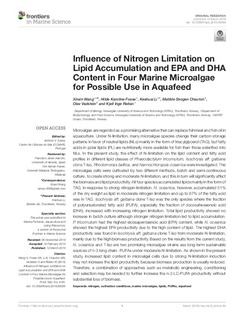| dc.contributor.author | Wang, Xinxin | |
| dc.contributor.author | Fosse, Hilde Karoline | |
| dc.contributor.author | Li, Keshuai | |
| dc.contributor.author | Chauton, Matilde Skogen | |
| dc.contributor.author | Vadstein, Olav | |
| dc.contributor.author | Reitan, Kjell Inge | |
| dc.date.accessioned | 2019-04-11T05:58:43Z | |
| dc.date.available | 2019-04-11T05:58:43Z | |
| dc.date.created | 2019-03-08T09:25:25Z | |
| dc.date.issued | 2019 | |
| dc.identifier.issn | 2296-7745 | |
| dc.identifier.uri | http://hdl.handle.net/11250/2594107 | |
| dc.description.abstract | Microalgae are regarded as a promising alternative that can replace fishmeal and fish oil in aquaculture. Under N-limitation, many microalgae species change their carbon storage patterns in favor of neutral lipids (NLs) mainly in the form of triacylglycerol (TAG), but fatty acids in polar lipids (PL) are nutritionally more available for fish than those esterified into NLs. In the present study, the effect of N-limitation on the lipid content and fatty acid profiles in different lipid class of Phaeodactylum tricornutum, Isochrysis aff. galbana clone T-Iso, Rhodomonas baltica and Nannochloropsis oceanica were investigated. The microalgae cells were cultivated by two different methods, batch and semi-continuous culture, to create strong and moderate N-limitation, and this in turn will significantly affect the biomass and lipid productivity. All four species accumulated lipids mainly in the form of TAG in response to strong nitrogen limitation. N. oceanica, however accumulated 51% of the dry weight as lipid in moderate nitrogen limitation and up to 87% of the fatty acid was in TAG. Isochrysis aff. galbana clone T-Iso was the only species where the fraction of polyunsaturated fatty acid (PUFA), especially the fraction of docosahexaenoic acid (DHA) increased with increasing nitrogen limitation. Total lipid productivity showed no increase in batch culture although stronger nitrogen limitation led to lipid accumulation. P. tricornutum had the highest eicosapentaenoic acid (EPA) content, while N. oceanica showed the highest EPA productivity due to the high content of lipid. The highest DHA productivity was found in Isochrysis aff. galbana clone T-Iso from moderate N-limitation mainly due to the high biomass productivity. Based on the results from the current study, N. oceanica and T-Iso are two promising microalgae strains as long-term sustainable source of n-3 long chain -PUFAs under moderate N-limitation. As shown in the present study, increased lipid content in microalgal cells due to strong N-limitation induction may not increase the lipid productivity because biomass production usually is reduced. Therefore, a combination of approaches such as metabolic engineering, conditioning and selection may be needed to further increase the n-3 LC-PUFA productivity without substantial loss of biomass. | nb_NO |
| dc.language.iso | eng | nb_NO |
| dc.publisher | Frontiers Media | nb_NO |
| dc.rights | Navngivelse 4.0 Internasjonal | * |
| dc.rights.uri | http://creativecommons.org/licenses/by/4.0/deed.no | * |
| dc.title | Influence of nitrogen limitation on lipid accumulation and EPA and DHA content in four marine microalgae for possible use in aquafeed | nb_NO |
| dc.type | Journal article | nb_NO |
| dc.type | Peer reviewed | nb_NO |
| dc.description.version | publishedVersion | nb_NO |
| dc.source.journal | Frontiers in Marine Science | nb_NO |
| dc.identifier.doi | 10.3389/fmars.2019.00095 | |
| dc.identifier.cristin | 1683152 | |
| dc.relation.project | Norges forskningsråd: 248355 | nb_NO |
| dc.relation.project | Norges forskningsråd: 239001 | nb_NO |
| dc.description.localcode | Copyright © 2019 Wang, Fosse, Li, Chauton, Vadstein and Reitan. This is an open-access article distributed under the terms of the Creative Commons Attribution License (CC BY). The use, distribution or reproduction in other forums is permitted, provided the original author(s) and the copyright owner(s) are credited and that the original publication in this journal is cited, in accordance with accepted academic practice. No use, distribution or reproduction is permitted which does not comply with these terms. | nb_NO |
| cristin.unitcode | 194,66,10,0 | |
| cristin.unitcode | 194,66,15,0 | |
| cristin.unitname | Institutt for biologi | |
| cristin.unitname | Institutt for bioteknologi og matvitenskap | |
| cristin.ispublished | true | |
| cristin.fulltext | original | |
| cristin.qualitycode | 1 | |

